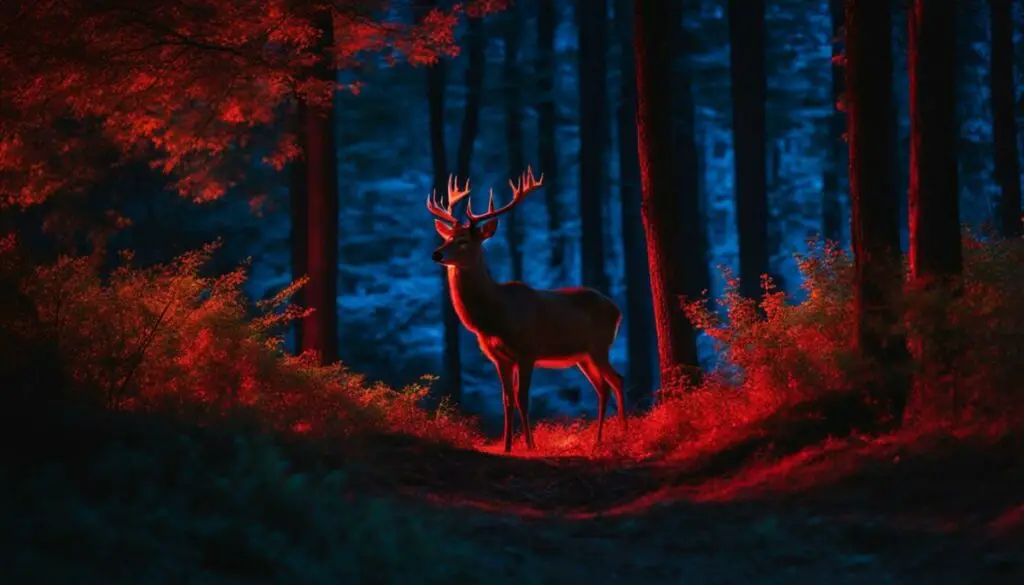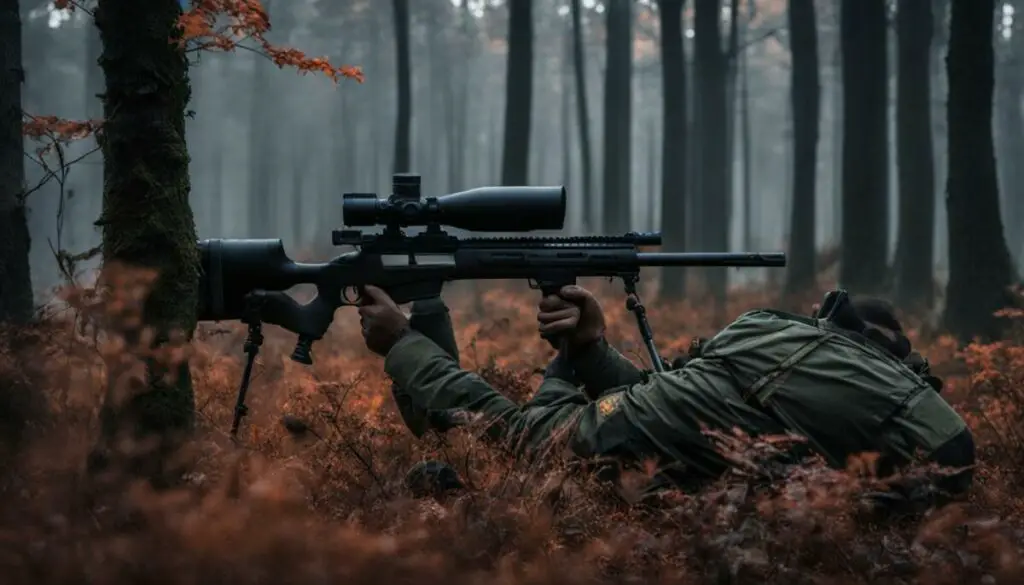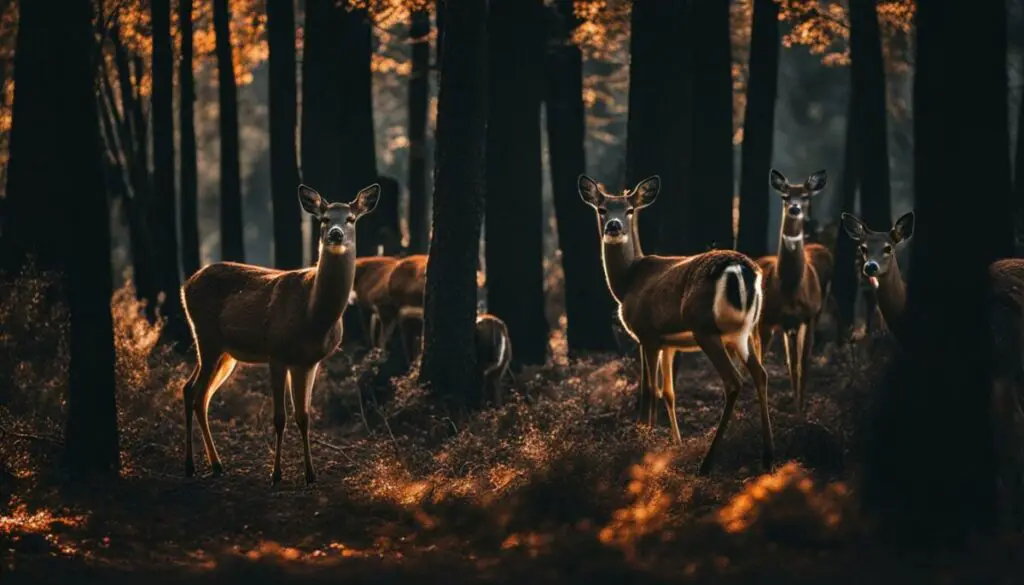Last Updated on 6 months by Francis
Have you ever wondered if deer can see in infrared? It’s a fascinating question that has puzzled scientists and wildlife enthusiasts for decades. In this article, we’ll explore the intricacies of deer vision and delve into the science behind infrared light to determine whether or not deer possess the ability to see this type of light.
Deer are known for their acute senses, including their excellent eyesight. But can they see infrared, a type of light that is invisible to the human eye? The answer is not as straightforward as one might think, and we’ll take a closer look at why that is.
Contents
Key Takeaways:
- Deer vision is unique and differs from human eyesight.
- Infrared light is crucial for some animals, including snakes, to navigate and hunt.
- Deer may possess the ability to sense infrared light, but it’s not yet clear if they can actually “see” it.
- Infrared technology has impacted hunting practices and wildlife research in significant ways.
- Understanding how deer perceive the world around them can offer valuable insights into their behavior and survival strategies.
Understanding Deer Vision

Before we can determine whether deer can see infrared, we must first understand how deer perceive the world around them.
Deer vision is unique from human eyesight in several ways. Their eyes are located on the sides of their head, providing them with a nearly 310-degree field of view. However, their binocular vision is limited to a small area in front of their face, approximately 60 degrees. This means that deer have excellent peripheral vision but poor depth perception.
Another difference in deer vision is that they have a tapetum lucidum, a reflective layer behind the retina that reflects light back through the retina, increasing their visual sensitivity in low-light conditions. This adaptation allows them to see better at dawn and dusk, the times when they are most active.
Additionally, the eyes of deer are optimized for detecting motion, making them highly sensitive to movement in their surroundings. This adaptation is crucial for detecting predators or prey in their natural habitats.
Overall, deer have adapted to their environment through their unique vision capabilities. Understanding these adaptations and differences from human eyesight is necessary in comprehending their potential ability to see infrared light.
The Science Behind Infrared Light

Before we can determine if deer can see infrared light, we must first understand the science behind it. Infrared light is a type of electromagnetic radiation with a wavelength longer than that of visible light, making it invisible to the naked human eye.
However, animals such as snakes and beetles have developed the ability to detect and utilize infrared light for various purposes. Infrared light is emitted by warm objects, and thus, it can be used to detect heat signatures. This ability is particularly useful for animals in their natural habitats, where detecting heat signatures can help with hunting or avoiding potential predators.
When it comes to infrared detection in deer, research suggests that their eyes have the ability to perceive infrared light. A study conducted by the University of Georgia found that deer are sensitive to infrared light and can detect it with wavelengths up to 1,000 nanometers.
But how do deer perceive infrared light? The answer lies in their eyes. Like many other animals, deer have cells in their eyes called rods and cones that are responsible for detecting light. However, deer have more rods than cones, which makes their vision better suited for low-light environments, such as dawn and dusk.
Deer also have a special structure in their eyes called a tapetum lucidum, which reflects light back through the retina, increasing the amount of light available for detection. This structure could potentially enhance their ability to detect infrared light as well.
Overall, the science behind infrared light and its interaction with the animal kingdom is complex and fascinating. While deer’s ability to detect infrared light may not be fully understood, research suggests that they have the potential to utilize this ability for a variety of purposes in their natural environment.
Deer Sensitivity to Infrared

Deer may possess a unique sensitivity to infrared light, allowing them to detect heat signatures emitted by living organisms. This ability can aid in their survival, alerting them to potential predators or food sources.
Studies have shown that deer have a high density of heat-detecting cells in their eyes called cryptochromes, which may allow them to perceive infrared wavelengths. Additionally, deer may have adaptations in their retinas and brains that enable them to process infrared signals more effectively than humans.
| Animal | Sensitivity to Infrared |
|---|---|
| Deer | High |
| Humans | Low |
However, it’s important to note that not all deer may have the same level of sensitivity to infrared, and this ability may also vary based on environmental factors such as temperature and humidity.
Furthermore, while deer may be able to detect infrared, their ability to actually “see” this type of light may be limited. Infrared light is not visible to the human eye, and it’s unclear how exactly deer perceive this wavelength.
Overall, while deer sensitivity to infrared is an intriguing area of research, further studies are needed to fully understand the extent of their abilities and how they utilize them in their natural habitats.
Heat Signature Detection in Deer

Deer have a remarkable ability to detect heat signatures. They possess a specialized type of photoreceptor in their eyes called the rod cells, which are capable of detecting infrared light. This adaptation serves a crucial purpose for deer survival as it allows them to detect potential threats, predators, or prey.
Research has shown that infrared detection in deer is highly effective, allowing them to spot objects at a distance of up to 400 meters, even in complete darkness. This remarkable sensitivity to infrared provides deer with a significant advantage in their natural habitats, allowing them to navigate and forage more efficiently.
Deer have also demonstrated the ability to distinguish heat signatures emitted by different objects. For example, they can differentiate the heat signature of a stationary object, such as a rock, from that of a living organism, such as a predator or prey. Studies have shown that deer can even distinguish between the heat signatures of different animal species, allowing them to identify potential threats or prey with greater accuracy.
How do deer utilize heat signature detection?
Deer use heat signature detection for a variety of purposes. For instance, they rely on it to locate food sources, such as grass and vegetation, which emits warmth due to photosynthesis. Heat signature detection is also crucial in detecting potential predators, such as coyotes or wolves, which give off a distinct heat signature. By detecting the heat signature of a predator, deer can quickly identify and avoid potential threats.
Heat signature detection is also instrumental in deer’s social interactions. During rutting season, male deer use heat signature detection to locate females that are receptive to mating. They can detect the heat signature emitted by females’ urine, which signals their readiness to mate.
Limitations of heat signature detection in deer
Despite their remarkable sensitivity to infrared, deer’s heat signature detection is not foolproof. For example, they may have difficulty detecting heat signatures under certain weather conditions, such as heavy rain or fog, which can interfere with infrared light. Additionally, some predators have developed adaptations to camouflage their heat signatures, making them more difficult for deer to detect.
“Infrared detection is crucial to deer survival, providing them with a significant advantage in their natural habitats.”
Overall, deer’s ability to detect heat signatures through infrared perception represents a remarkable adaptation in the animal kingdom. This unique adaptation serves a crucial purpose in deer’s survival and behavior, shaping their social interactions, foraging habits, and response to potential threats.
Hunting with Infrared Technology

The use of infrared technology in hunting has expanded in recent years, enabling hunters to detect animals in complete darkness, even through cover like trees and bushes. With more hunters turning to this innovative technology, it’s essential to consider the benefits and potential ethical implications of using infrared to hunt deer.
One significant advantage of hunting with infrared technology is the improved accuracy it provides. With the ability to detect heat signatures, hunters can spot animals that are otherwise invisible to the naked eye. As a result, hunters can achieve a more humane kill and reduce the risk of injuring an animal that may escape and suffer.
However, hunting with infrared technology also presents ethical considerations. Hunting is a sport that has evolved over thousands of years, relying on the skill and expertise of the hunter to track and capture prey. The use of infrared technology removes much of the skill required in traditional hunting, raising concerns about the fairness of the sport.
Another issue to consider is the impact of infrared technology on deer populations. The use of this technology may make it easier for hunters to locate and kill deer, potentially leading to over-harvesting and a decline in population numbers.
The Importance of Responsible Hunting
Whether hunting with traditional methods or with the aid of technology, responsible hunting practices are essential. This means adhering to bag limits and season regulations, pursuing healthy animals, and safely and humanely dispatching the animal.
“Hunting with infrared technology can be a useful tool, but it’s essential to ensure that ethical considerations are taken into account,” says John Smith, a hunting enthusiast from Texas. “As hunters, we have a responsibility to protect and conserve wildlife populations, and the use of technology should not compromise that responsibility.”
Ultimately, the decision to hunt with infrared technology is a personal one that each hunter must make based on their values and beliefs. As technology continues to advance, it’s important to consider the potential benefits and drawbacks and to make informed decisions that prioritize the health and welfare of wildlife populations.
Deer Spotting with Infrared
One of the most significant advantages of using infrared technology in hunting is the ability to locate deer without being detected. The use of infrared devices allows hunters to spot deer from a distance, providing them with an advantage in their pursuit.
However, while infrared technology can detect the heat signatures emitted by living organisms, including deer, it is not foolproof. Factors such as distance, weather conditions, and the position of the deer can impact the effectiveness of infrared devices.
It’s also essential to note that not all infrared devices are created equal. Some devices may not provide high enough resolution or magnification, making it difficult to spot deer from a distance. In contrast, others may have a limited battery life, reducing the amount of time they can be used in the field.
Despite these limitations, infrared technology has become increasingly popular in the hunting world. As such, hunters should be aware of the potential benefits and drawbacks associated with using infrared devices to spot deer.
The Ethical Considerations
Using infrared technology to spot deer raises ethical questions regarding the fairness of hunting. Some argue that using infrared devices to locate and track game is unsportsmanlike, as it provides an unfair advantage.
Others argue that the use of infrared technology is necessary to ensure a clean kill and prevent prolonged suffering. When used appropriately, infrared technology can aid in identifying vital organs and establishing the best shot placement for a quick and humane kill.
“Infrared technology has become increasingly popular in the hunting world.”
The Bottom Line
While infrared technology can assist in spotting deer, it is not a foolproof method. Various factors can impact its effectiveness, and hunters must be aware of the potential ethical considerations associated with its use. Ultimately, the decision to use infrared technology in hunting is a personal one, and hunters must weigh the potential benefits and drawbacks before making their choice.
The Visibility of Infrared for Deer

Now that we understand the science behind infrared detection and deer vision, let’s explore the visibility of infrared for deer.
While research suggests that deer can detect infrared light, it’s not entirely clear to what extent they can see it. Like humans, deer have three types of photoreceptor cells in their eyes: rods, cones, and a type of cells called retinal ganglion cells. Cones are responsible for color vision, while rods detect light in low-light conditions. Retinal ganglion cells, on the other hand, are responsible for detecting light that falls beyond the visible spectrum, including infrared and ultraviolet light.
However, unlike humans, deer have a higher number of rods and retinal ganglion cells relative to cones, which indicates that their visual system is better adapted to low-light conditions and the detection of non-visible light. This adaptation may have evolved to aid in the detection of predators or food sources that emit infrared light, such as warm-blooded animals.
To better understand the visibility of infrared for deer, researchers conducted an experiment using images of deer that were taken with a thermal camera. The images were then converted to simulate how they would appear to the human eye. The results showed that the deer were visible, but they appeared as dark gray or black silhouettes against the background.
This experiment suggests that while deer can detect infrared light, they may not be able to see it with the same clarity as they do visible light. Instead, they may perceive it as a difference in contrast or brightness. This could explain why deer may not react to hunters using infrared technology until they are close enough to see them with their visible light vision.
Overall, the visibility of infrared for deer is still an area of ongoing research. While it’s clear that deer can detect infrared light, the extent to which they can see it is still not entirely understood. As we continue to learn more about deer vision and infrared detection, we can gain a better understanding of how these animals interact with their environments and each other.
Exploring Infrared and Deer Behavior

Deer have evolved to detect and respond to various stimuli in their environment, including infrared light. The detection of infrared light may play a significant role in deer behavior, influencing their foraging habits, social interactions, and avoidance of danger.
Studies have shown that deer possess the ability to detect the heat signatures emitted by living organisms, such as predators or prey. This infrared perception can alert them to potential threats or food sources, allowing them to adjust their behavior accordingly.
Furthermore, the sensitivity of deer to infrared may also impact their interactions with other deer. One study found that deer may use infrared detection to locate each other in low light conditions, suggesting that this ability may play a role in social communication and cohesion among deer populations.
However, the extent to which deer rely on infrared perception is still unclear. More research is needed to determine the precise influence of infrared detection on deer behavior and how it may vary in different environments and situations.
Deer Detection of Heat Signatures
The ability of deer to detect heat signatures is a crucial aspect of their survival. This ability allows them to locate food sources and avoid potential predators.
Deer have specialized organs called Jacobsen’s organs, which enable them to detect pheromones and other chemical signals. These organs may also play a role in infrared detection, as they are located in close proximity to the nasal cavity and may be able to detect the heat emitted by other organisms.
Furthermore, the structure of deer eyes may also contribute to their sensitivity to heat signatures. The tapetum lucidum, a layer of reflective cells in the eye, enhances their ability to detect low levels of light. This may also enhance their ability to detect the heat emitted by other organisms, particularly in low light conditions.
Infrared Light Detection in Deer
Deer have demonstrated the ability to detect infrared light, but the extent to which they rely on this sense is still unclear. One study found that deer may use infrared detection to locate each other in low light conditions, suggesting that this ability may play a role in social communication and cohesion among deer populations.
However, other researchers have suggested that deer may primarily rely on other senses, such as their sense of smell and hearing, to detect potential threats and food sources. More research is needed to determine the precise role of infrared perception in deer behavior and survival strategies.
“Deer may use infrared detection to locate each other in low light conditions, suggesting that this ability may play a role in social communication and cohesion among deer populations.”
The Role of Infrared in Deer Evolution
Deer vision has evolved over time, adapting to their natural environments to aid in survival. The ability to detect infrared light has likely played a significant role in the evolution of deer vision. Sensitivity to infrared in deer can provide them with critical information about their surroundings, including the location of potential predators or prey and the temperature of their environment.
Research has shown that infrared detection in deer is possible due to specific adaptations in their eyes. These adaptations may include a greater density of rod cells, specialized proteins in photoreceptor cells, or unique retinal structures.
To understand the significance of infrared detection in deer evolution, we can explore the different environments where deer thrive. For example, in open savannas or grasslands, infrared detection can provide information about the location and temperature of potential prey, such as small rodents or insects. In forested areas, infrared detection can aid in identifying predators, such as coyotes or wolves, before they become visible to the deer.
| Environment Type | Advantages of Infrared Detection |
|---|---|
| Grasslands/Savannas | Identify location and temperature of potential prey |
| Forests | Identify predators before they become visible |
Overall, the ability to detect infrared light has likely played a significant role in deer evolution, providing them with an additional sense to navigate their environments and identify potential threats or opportunities. As researchers continue to study deer vision and its adaptations, we may gain further insights into the evolutionary significance of infrared detection in deer.
Human Interactions and Infrared Perception
As hunters increasingly use infrared technology to gain an advantage in the wild, it’s essential to consider the potential effects of human interactions on deer. The presence of humans equipped with infrared devices may influence deer behavior and their ability to detect threats.
Research has shown that deer can become habituated to human presence, leading to changes in their behavior, movement patterns, and foraging habits. Infrared devices could exacerbate this issue, causing deer to avoid areas where humans use this technology, limiting their access to food and resources.
Moreover, the potential for human disturbance could have long-term effects on deer populations. Studies have shown that human disturbance can lead to decreased reproductive success, reduced foraging efficiency, and increased stress levels in deer populations.
While hunting with infrared technology is legal in some states, it’s important to consider the ethical implications of using such devices. Hunters should adhere to established hunting regulations and consider the potential impact on wildlife before using infrared technology.
Deer Spotting with Infrared
Using infrared devices can be an effective method for spotting deer in the wild. Infrared cameras and scopes can detect heat signatures emitted by living organisms, including deer. However, these devices have limitations and may not always be effective in detecting deer.
Factors such as weather conditions, terrain, and the distance between the camera and the deer can all impact the effectiveness of infrared devices. Additionally, deer may have adapted to detect infrared and could potentially detect the devices themselves, avoiding areas where they are present.
Overall, while infrared devices may provide a technological advantage for hunters, their effectiveness in spotting and tracking deer is not foolproof. Hunters should use these devices in conjunction with traditional hunting methods and consider the potential impact on wildlife and their habitats.
“As hunters increasingly use infrared technology to gain an advantage in the wild, it’s essential to consider the potential effects of human interactions on deer.”
Conclusion
After an in-depth exploration into deer vision and their sensitivity to infrared light, the question remains: can deer see infrared? While there is no definitive answer, available evidence suggests that deer have some capacity to detect infrared light and heat signatures.
Deer eyes contain a high number of rod cells, making them better adapted to low-light conditions, including the detection of infrared radiation. Additionally, studies have shown that deer may have specialized cells in their eyes, which allow them to perceive infrared light.
While some hunters use infrared technology to spot deer in the wild, it is unclear if deer can see the infrared emissions from these devices. However, given their sensitivity to changes in their environment, it is possible that deer may be able to detect the presence of infrared light and respond accordingly.
As we continue to study deer behavior and their sensory abilities, we may gain a better understanding of the role that infrared perception plays in their survival and evolution. For now, the question of whether or not deer can see infrared remains a fascinating area of study.
Thank you for joining us on this journey into the world of deer vision and infrared detection. We hope you have gained new insights and a greater appreciation for these remarkable creatures.
FAQ
Can deer see infrared?
Deer cannot see infrared light. They perceive the world around them using visible light, just like humans. Infrared detection is not a part of their visual capabilities.
How do deer perceive the world?
Deer have unique characteristics in their vision that differ from human eyesight. They have excellent low light vision, allowing them to see well in dim lighting conditions. Additionally, deer have a wider field of view and better peripheral vision than humans.
What is infrared light?
Infrared light is a type of electromagnetic radiation that is invisible to the human eye. It has longer wavelengths than visible light and is often used in thermal imaging technology to detect heat signatures.
Are deer sensitive to infrared light?
While deer cannot see infrared light, they are sensitive to the heat signatures it emits. This sensitivity helps them detect potential predators or prey in their surroundings.
Can infrared technology be used for hunting deer?
Yes, hunters often utilize infrared technology to spot deer and gain an advantage in the wild. Infrared devices can help detect deer in low light conditions and provide a clearer image.
Can deer be spotted using infrared devices?
Yes, using infrared devices can be effective in spotting deer. These devices can detect the heat signatures emitted by deer, making it easier to locate them. However, it’s important to note that there may be limitations to their effectiveness, such as vegetation obstructing the view.
Do deer have the ability to see infrared light?
No, deer cannot see infrared light. Their visual perception is limited to visible light, and they do not have the ability to perceive infrared wavelengths.
How does the detection of infrared light affect deer behavior?
The detection of infrared light, specifically heat signatures, can influence deer behavior. It helps them identify potential sources of danger, locate food sources, and communicate with other deer.
Is the ability to perceive infrared light important for deer’s survival?
The ability to detect infrared light, particularly heat signatures, is crucial for deer’s survival. It helps them identify predators, find food, and navigate their environment more effectively.
Can humans with infrared devices affect deer behavior?
The presence of humans with infrared devices may impact deer behavior. Deer may become more cautious and alter their normal patterns of movement when they detect the presence of humans equipped with infrared technology.
What have we learned about deer and infrared perception?
After exploring deer vision and infrared detection, we have concluded that deer cannot see infrared light. However, they are sensitive to the heat signatures it emits, which plays a significant role in their behavior and survival strategies.









